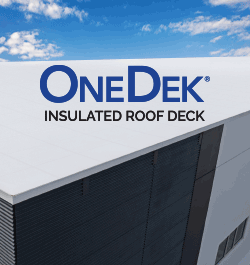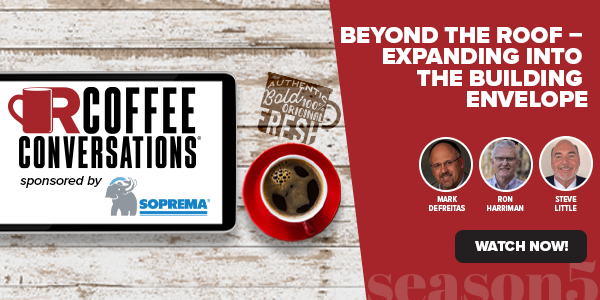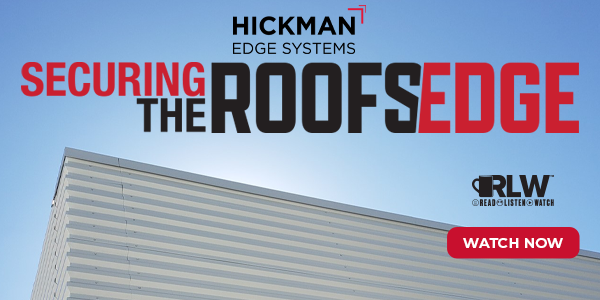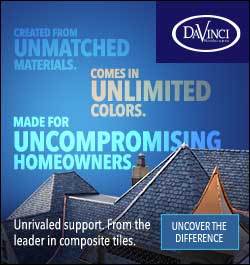Beyond the Roof – Expanding Into the Building Envelope - PODCAST TRANSCRIPT
January 29, 2024 at 12:00 p.m.Editor's note: The following is the transcript of a live interview with Steve Little from KPost Roofing & Waterproofing, Mark Defreitas from Soprema and Ron Harriman from Benchmark, Inc. You can Read the interview below, Listen to the recording or Watch the video.
Heidi J Ellsworth: Good morning and welcome to Coffee Conversations from RoofersCoffeeShop. My name is Heidi Ellsworth and thank you so much for being here this morning. We are so excited about today's conversation. It's something that every commercial contractor and, I think, residential contractor, too, needs to be aware of, and that is how we are looking at the building envelope. What are we doing? We own the roof, but are we looking at the rest of the building? How can that differentiate and grow your business?
Before we get started with our esteemed panel, let's go through a few little bit of housekeeping. First of all, this is being recorded and it will be available within 24 hours. Be sure to check it out, send it out to your friends. It can be found under Coffee Conversations on rooferscoffeeshop.com. Also, this is a conversation, so we want you to chat, ask questions, make comments, let us know who you are and where you're from, and throughout the entire conversation, be a part of that conversation. Please, the chat is open. Please let us know who you are, where you're from, what kind of business you have and we'll keep that chatting and conversation going throughout the entire hour ahead.
Let's get started. First of all, I would like to thank our sponsor for today, SOPREMA, a leader in the building envelope and sustainability. They are an amazing company that really brings the whole picture together for contractors. We are so honored to have them as our sponsor and to also have Mark today here on our panel. Welcome, Mark. Thank you so much for being here today.
Mark Defreitas: Thanks, Heidi. Appreciate you inviting me. Appreciate everything you're doing for the industry.
Heidi J Ellsworth: I love it. I love this. You and I sit in so many meetings, so many across from each other, panels where we're working on things. I'm always inspired by what you have to say and really the leadership of SOPREMA. First of all, let's start, if you could introduce yourself and tell us a little bit about what you do at SOPREMA and a little bit about SOPREMA.
Mark Defreitas: Sure. First of all, just because I know they can read some of my information, I want to let you know that I was blessed to join this industry over 34 years ago. A matter of fact, I know many people know this, but I joined my father-in-law's roofing contractor business. I started out in the roofing industry in the roofing side of the business. Spent a little bit of time there and then moved into the manufacturer side. And then, in the last 12 years, I've been with SOPREMA as the VP of national and strategic accounts. The other thing I want to highlight is the importance of volunteering in our industry. Nothing happens without the great collaboration and commitment from members. I've made a point over my career to try and give back, and so I am involved with NRCA and with ARMA. Thanks for the opportunity to explain a little bit what I do.
Heidi J Ellsworth: I love it. Tell us a little bit about SOPREMA for those few people out there who may not know.
Mark Defreitas: SOPREMA is a family business, one of the few family large roofing manufacturer, building envelope solutions provider going back to the early 1900s. Originally out of Europe, has significant resources throughout the world. Obviously, I'm out of the United States side of the business and we have always been in the building envelope side of the business from our European roots. But obviously over the last, oh, gosh, last two to 5 years, 10 years, we've really expanded into the building envelope side of the business.
Heidi J Ellsworth: Excellent. Excellent. Thank you again for sponsoring and for being here today, Mark. I appreciate you so much. Then I am honored to welcome and introduce Ron Harriman with Benchmark. Ron, if you could introduce yourself and please tell us a little bit about your company.
Ron Harriman: Yeah, thanks for having me, Heidi. I'm glad to be here and participate. Hopefully, we can all learn something. Yeah. My name's Ron Harriman. I'm with Benchmark and I've been in the roofing industry since 1984. I spent the first nine years of my career on the roof contracting side of the business, and since that time I've been with Benchmark. Benchmark is a national roof and also pavement consulting company. About 80% of our business is roofing and then the balance is on the paving side, roofing/waterproofing. We serve a national clientele pretty much all over the US, primarily in North America, a little bit of international work as well. But I think one of the things that enables us to do is to become very well-rounded. When we see such a variety of climates, building types, techniques, contractors, it almost prevents a specific bias. You learn the hard way that there's no one thing that works everywhere. To have that opportunity, I think, has put us in a position to be good problem solvers and helpful hopefully as we sit around a table with the other participants in a project to try and solve big problems.
Heidi J Ellsworth: Right. I love it. If all you out there aren't catching this already, manufacturer, consultant... Thank you, Ron. Ron, you and I had this great conversation earlier about how important it is that the consulting community and the contracting community and the manufacturing community are all having strong conversations. We're going to do that today, so thank you so much for being here.
Ron Harriman: You're welcome.
Heidi J Ellsworth: We need a contractor. Who should we talk to? Of course, Steve Little with KPost. Steve, please introduce yourself and tell us a little bit about your company.
Steve Little: Heidi, thank you for the opportunity to be here with these prestigious gentlemen of our industry. My name is Steve Little. I'm head coach and president of KPost Roofing & Waterproofing and Solar, as well as the CEO of National Roofing Partners and the founding partner. I've been in the industry... This is my 24th year. As Mark said earlier, we're truly blessed to be in this industry, to be able to provide the shelter part of food, water and shelter for all of humankind, actually. It's an honor to be able to be in a company that has that sense of integrity and that sense of care and get involved with our industry.
I've been involved with a few of the regional associations and I'm currently on the NRCA committees. A number of different committees are there on the foundation for NRCA, which is the Roofing Alliance. I'm honored to be here representing KPost as a contractor as we speak with Ron and Mark, who we've been fortunate enough to do some pretty large projects and complicated projects with both of them. Thanks for the invitation.
Heidi J Ellsworth: I love it. I'm excited to hear about those collaborations. Okay, let's start this out with really what we are talking about, too, is in this industry we have some amazing roofing companies. They are on the roof and they are working on the roof, but are they really looking at the building overall, not only to maybe expand their business and differentiate but also just really understanding those tie-ins? We want to start with that. We really want to start with all of you sharing... With the traditional focus of the roof, why should contractors be looking at the building holistically? I'm going to start with you, Mark, and we're going to work our way through this. But why should contractors and, I mean, obviously, consultants, but why should contractors be looking at this?
Mark Defreitas: Sure. I'll just throw a couple out there. I'm sure Steve and Ron have some additional thoughts, but one that comes to mind is scheduling. When you are working with multiple applicators in the contractors on that job group site, you have to work through some of the scheduling. If you've got different people doing different parts of the building envelope, you're going to have to understand how that affects your business. That's one. I'm sure Steve will go a lot more into detail on that one.
And then, [inaudible 00:09:03] side of things, the important part is the integration, the tie-ins. That's a big challenge, how the different products... Are they compatible? The detail, is it functionally workable versus just looking good on a drawing board? I think the integration of the tie-ins is a challenge for manufacturers, as well as the waterproofer or the contractor.
Those are the two big ones or at least two big ones I see, scheduling and then the compatibility and the working of the details, which is really big in our industry because if you have different numbers out there. But, I guess, typically or at least a rough number is 80% of your roofing challenges come from those details and integration points. It's a big issue. The more we have compatibility and more we have collaboration, the better performance you're going to have. There's just a couple things.
Heidi J Ellsworth: Well, Ron take us through that, too, because... I mean, I know Benchmark focuses a lot on the roof, but you also are looking at the building envelope. How has that worked with you in working with your customers and with contractors?
Ron Harriman: Yeah. I think if you go back to what's driving this or even the potential of contractors considering pursuit of this or increasing their knowledge in this, their capabilities in the area of waterproofing or building envelope, I think part of it is there's an old adage that if there's no problem, there's no sale. Well, it's because there's been problems that I think there's now an opportunity. Unfortunately, the problems can be expensive and they can be difficult to solve. Likewise, the solutions can put a building in a compromised position. The idea is that you get one chance to do it right and that's the first time.
I love it when we can... Like Mark mentioned scheduling, I just think that's oftentimes call it the sequence of work or the timing of the first conversations. When a roofing contractor is brought in and the threshold heights are already set, we have to work with that. But if we're at the table a little bit sooner and we can start impacting some decisions... That takes trust, that takes relationships, but I'd say if we can really insert ourselves in a collaborative voice trying to pull the right team members into it, then we've got a far greater chance for success.
Heidi J Ellsworth: Yeah, I agree. I also think architecture is starting to change a little bit how we think about it, too, because sometimes you don't know where the roof begins and where it ends. Steve, you have those kinds of projects.
Steve Little: Yeah, you said it really well. Where does the roof end and where does the rest of the building begin? This has been a natural evolution tied to the computer age and tied to consolidation. We've seen a great deal of consolidation in the material side of our business and the distribution side of our business. Now, it's coming actually in the building envelope side of our business. We were challenged years ago that people like the work that we did on the roof. Could we also move to the building envelope side of the business? Because of all the tie-ins that Mark mentioned, the warranty considerations that Ron specifies... Instead of a customer, whether it be on the remedial side or on the new construction side, they want to have one warranty, one contact that they can go to.
The largest amount of lawsuits are tied to building envelope. It is the number one item in the entire industry. General contractors are looking for those contractors that will take the responsibility for the whole building, but we have to be careful because it's two different crafts. Our industry is made up of craftsmen, craftswomen who go in the marketplace and actually perform an installation of a craft. It's really recognized sometimes more on the metal side and the copper and all the cool stuff that's on that side of the business. But what we do, and I know many contractors like KPost does, is that we realize that it's a craft to make sure that those seals are all done, that all those tie-ins are done are put together, that the building is in a watertight condition.
We don't want to have a situation like Mark Cuban had with the Mavs during the playoff game a couple of years ago that the television stopped. All the talking heads got to talk about what was going on with the Mavs building. Fortunately now for Mr. Cuban and for the rest of the fans, that SOPREMA roof installed by KPost is keeping that building dry. But after we finished working on that building, we also went through and did an entire tie-in all the waterproofing side of the business using SOPREMA products. Again, single manufacturer, single contractor building envelope.
Heidi J Ellsworth: Steve, I want to keep going on that, because this hasn't always been the case. When do you see... Within the last couple of years, and IIBEC, which used to be RCI, has really led the industry down this. I would love your thoughts on how much have they helped to lead this and how much is it just, what you're saying, within the last couple of years that owners, consultants, manufacturers have seen that there are contractors who can take on this bigger picture of the building envelope?
Steve Little: Well, I think it started with the client, whether it be the general contractor, the developer or actually the building owner that wanted to minimize the number of touches that people had to their building. Lots of times, what happens is that in a remedial situation, if the roof starts to leak, the HVAC person says, "It's the roofer," the roofer says, "It's HVAC," and there's just kind of... Who's going to take care of this whole scenario? So, the owners were looking for a single point of contact. Then the specifiers through IIBEC and through wanting to have control of the entire building envelope started specifying specific manufacturers, like a SOPREMA, that would have the entire building envelope of products.
There's only a few of those folks in our industry. A lot of the commodity roofing contractors do not specialize in that side of the business. But folks like Benchmark and SOPREMA realize that we have to take a step-up, that the building envelope is not a commodity. It is what keeps everything inside that building dry, including human beings. If you're dealing with a national retailer like NRP would be dealing with, the slip and fall cases that come out of that, where they're constantly blaming the roof. Something is there. Well, no, it really wasn't the roof, it was the HVAC or the waterproofing side of the business. They want to bring it all under one responsibility.
Heidi J Ellsworth: And you're seeing a higher demand for that?
Steve Little: Yes, ma'am, very much so. It's driven also by the client to begin with, but it's also driven by the expectations of the manufacturer and the expectations of professionals like the folks at Benchmark. I mean, they want to have somebody that is going to invest in their business. Just being a waterproofer today or just doing air barriers or just doing coatings or even doing roofing, it is not meeting the standard of expectations being set up by the folks like at Benchmark or SOPREMA.
Heidi J Ellsworth: Ron, you are seeing this. I would love to see your thoughts on what Steve just said, that this is being driven by the client, that they're looking for this. Also, again, that whole transition from RCI to IIBEC a couple of years ago and how that's really changed the conversation, too.
Ron Harriman: Yeah. I thought it was interesting that Steve got his fingers going there a couple of times, because that's what you want to avoid. At least if we're going to point at something, let's not point at each other. Let's point at the issue. I think a lot of times it does start with the client. We're all trying to respond to the needs of our client, kind of hit the bullseye in terms of their objectives. Really, does anybody have an objective that would be short of saying, "I want to keep water out of my building"? It's pretty basic, but it's not easy. Simple but not easy.
One of the best principles of waterproofing is keep the water away from the waterproofing. Again, I'm probably repeating myself, but when we had this collaboration and not just pointing at each other but pointing at issues, but then doing it earlier so that then someday you don't find yourself solving the problem, but then still being left with the question, well, who pays for it? It's like when you get involved collaborating, solving issues, anticipating issues earlier than that collaborative... Bring all the brains to the game. I think sometimes the speed of construction, the speed of, "Hey, get this building in the dry," it drives us and all of a sudden we're kind of in a tunnel vision. We're focusing on speed and maybe lost sight of some of the other objectives. We almost need that community approach to make sure that, "Okay, there's a downside to that decision. Let's think that through because we only get one chance to do this right."
Heidi J Ellsworth: And that's really where-
Steve Little: Well, [inaudible 00:18:52] if I could echo what Ron had said, I want to tie in something that both the consultants and the manufacturers are doing. They are doing a great job of educating the client. Prices is an important factor of what transpires, but is it price on the front side or price on the backside? For people that own multiple facility buildings that actually own them, they don't lease them. They're not looking to flip them after seven years for a tax code scenario or an opportunity they're looking more and more in a long-term approach because of what the consultants and the manufacturers that understand the building envelope are bringing to the party, which is what we do at KPost is why we built a 60-person waterproofing department with waterproofing estimators and superintendents and people that specialize in just waterproofing. Because you can't have the waterproofer go put the roof on, you can't have the roofer go put the water... It just doesn't work.
Mark Defreitas: The energy efficiency and the codes will always be there, but one of the things that this whole collaboration that Ron and Steve are talking about, it's also helping us as a manufacturer become a better manufacturer by providing our customers with better solutions. A couple of examples of that is some of the products that we have, but also some of the holistic views that we have now. When we develop details, it's not just a detail for a roof section, it's also when we are providing our material, it's also covering the waterproofing and the roofing. We're now looking at how things work together and that they're compatible.
The other thing that we look at is our inspectors. When a field inspector goes up on the roof, they're not looking at just the roof, they're looking at how their waterproofing impacts the roof and vice versa. It's given us a much better holistic view. At the end of the day, when you talk about sustainability, it's really how do you make things last longer? Some of those things are becoming into fruition now with some of these efforts.
Heidi J Ellsworth: So, we don't have to put as much into the landfills, too.
Mark Defreitas: Exactly.
Heidi J Ellsworth: Yeah, big part of it. Mark, as you're talking to the contractors out there and encouraging them, obviously, you have the products across the board that can help them make those transitions to walls, to waterproofing, to whatever. I love, Steve, what you said about we have two different groups. We have experts in there. Mark, what are you seeing with other contractors across the country who are doing things similar to KPost?
Mark Defreitas: I'm seeing the roofing industry; roofing contractors have always been very good at adapting to the environment of hundreds of years. They've gone from tenners to residential, commercial. They've really taken on... As the environment has changed, they've moved with it. I'm seeing contractors that actually see the opportunities that they have with the waterproofing side, but I also see contractors understanding that, "You know what? Maybe that's not where I want to go." And that's good, too. Sometimes the best decision is the no decision. I'm seeing some smart decisions being made because there are resources that you're going to have to have to be able to do waterproofing in an effective, profitable way. That's the key.
Is there commitment and is there the resources to do that, to move into both areas? For the most part, you're seeing roofer contractors making those decisions: sometimes yes and sometimes no. The other thing that we have is the distribution where you've got a lot consolidation, but you're also seeing distribution moving into some of the big guys, moving into the waterproofing side. Now, they're exposing roofing contractors to the waterproofing side and you just got to be careful. You're just going to make the right decisions when you start branching out into some of these other things.
Heidi J Ellsworth: I think that's a perfect comment right there, because we just had Tammy... Good morning. Tammy. Thank you for being here. She just said, "Thank you for this webinar. We do a bit of waterproofing, but this is a space we want to grow into. Great discussion." I think there's a lot of contractors out there who want to add waterproofing. Ron, what are you seeing when you're working with contractors across the board and really who want to expand into that waterproofing? How are they working with you as a consultant to start having some of those conversations?
Ron Harriman: As you can imagine, there's a variety of scenarios. But if we'd kind of dwell over on what, I think, is a good scenario and not an unfortunate scenario... As a consultant, I would say that all too often we get called into this space because there's a problem. It's after the fact and then, wow, there's no magic wand to wave, but it's far more fun in getting involved in a proactive sense. I like it when a contractor will involve us maybe for the purpose of advice, to just engage in conversation about it. "What are you seeing? What do you like? Have you used these materials? Take a look at this curtain wall, tie in the threshold detail. What do you think?" I just love it when we get engaged early. Maybe we can pull the architecture team into the discussion.
You can tell when people are approaching it with the right level of respect, as opposed to thinking, "Oh, this is an easy expansion. You know what? We already got manpower on the job. We'll just go ahead and do the waterproofing, too, or we'll take care of your walls. We'll do everything." Well, that's sometimes a blind or a naive approach. But those that are asking good questions really have a... Let's make sure that everyone has the right level of respect for the technical aspect of this, even the safe work aspect of it, to think of the execution and the compatibility of materials.
There's just so many factors. It's hard to have wisdom in all areas. That's where I think that collaborative approach, asking questions... I know there's a lot of pressure on contractors to turn it around, get the bid out, and I would just caution, before you go dabble in it, try to get the right expertise. It doesn't have to be in-house at all times, but the right team. Once again, this third time, I'll emphasize it: do it early.
Heidi J Ellsworth: Yeah, do it early. Mark, both you and Steve are nodding. But when contractor... I love what Ron just said, "Be intentional." I think it's what... Intentional about that expansion. I want to talk to both of you about that, but, Mark, as you're seeing contractors come in, do you see that kind of research and that intentional like, "We are going to add waterproofing to it. Can you help us," conversation coming from your contractors?
Mark Defreitas: Yeah, I do. It's interesting. Some of the big guys are a little bit more further along and they've got the resources at hand and you've got the smaller entities that really lean on their resources, on their connections. I do see a little bit of both, but there's room out there. Certainly, the market, there's opportunity. I mean, people aren't getting into these spaces because there's no opportunity. There's opportunity, but to Ron's point, we've just got to be careful how you do it. For us as a manufacturer, we had the luxury of having sister companies in Europe and Canada that were way far advanced as far as products and expertise, so we can lean on that.
We had our own resources, too, but you also have to understand that every country's different. You have to make sure that you understand from a local side. I would say the same thing with [inaudible 00:27:22] contractors. They have to understand what they're in, what they're working on and how it works within their own locality. But certainly, there's a lot more interest today than there was 5 years ago, 10 years ago to get into this side of the business.
Heidi J Ellsworth: Yeah. I have a quick question here that, Mark, I want to address back to you, and this is from Kyle. Good morning, Kyle. We're so glad you're here as always. But he said, "Mark, what sort of contractor license is required for strictly waterproofing if they were to concentrate only on waterproofing?" I'm going to Steve after you, but what should they be looking at for their licensing?
Mark Defreitas: I can only speak for on the SOPREMA side that they would have to go through an approval process, which they would talk to their local salesperson or contact me. But there is a process on outside as far as a development of an agreement. But from an industry side of things, maybe Steve or Ron May have a better idea from an industry side. But from a SOPREMA side, we have an approved contractor applicator approval process that they would have to go through.
Heidi J Ellsworth: Steve, I was going to... This was the next question I was going to ask you. Because I know you were always so open to sharing, can you share how you did it? How did KPost add waterproofing? What was your process to make that change?
Steve Little: I think it was like most things we've done: we hired the right people. We hired Shawn Morgan over 10 years ago. He is currently our vice president of revenue and brand, but he started off coming into our company. He was from the waterproofing industry for 20 years and he joined our company and helped us develop a program. This is not an easy thing to do. I want to caution contractors that they need to be thinking of this as a long-term approach instead of a short-term approach. We invested in this for a number of years, losing money, not just making money by breaking even but losing money for a number of years until we could build up the staff, build up the tenure, build up the crafts folks that were able to actually execute the program.
The folks like SOPREMA don't give away full building warranty applicator agreements very easily. I mean, we do an excellent job on the roof side of the business and we feel like we're a leading contractor for SOPREMA and other contractors, other manufacturers in that part of the industry. But the waterproofing side is a whole nother game. The exposure that somebody like SOPREMA has to have the whole building envelope from one specific contractor is a huge risk. It's a long-term play, not a short-term play. Hire the right person first or acquire a smaller company first. Incorporate them in your business. Make sure they understand your core values and your reputation in the market.
We would not let our waterproofing company hurt our roofing reputation, so we started off by doing remedial jobs first, fountains, parking garages, remedial type stuff, to just get traction going and get a track record behind it. We did it with our multi-facility clients, like healthcare or data centers or industrial manufacturing. That's really where we started. We didn't go into the new construction side and, to this date, are still not 500,000 lineal feet cocker. That's not what we do. We'll do air barriers, we'll do entire programs, we'll break out a waterproofing package for a general contractor or a developer to specialize on where the tie-ins are, specifically to the roof and the building envelope side of the business or the ACM panels or all those different things that tie to the exterior side of the business. That's where we focus our energy, but we are in our eighth or ninth year on that side of the business.
Mark Defreitas: [inaudible 00:31:11]
Heidi J Ellsworth: Yes.
Mark Defreitas: I'll just add one more thing to Steve's comments. Training. SOPREMA is a great believer in training. We have a number of training centers throughout the United States and the world, as a matter of fact. But the key is this: we're a lot further ahead, we as the industry as far as training and opportunities. IIBEC has courses, AIA has courses. There's a bunch of waterproofing organizations that have training programs and there's a number of manufacturers outside of SOPREMA that has some good training. I would say for the roofing contractors who are looking to get into this to take advantage of the training that's out there because that will be helpful, too.
Heidi J Ellsworth: Yeah, I was going to ask you about that.
Steve Little: Know your lane. I'm sorry. I didn't mean to step on you, Heidi. Know your lane. Okay? The people that get in trouble in the roofing industry are just mesmerized by big titled projects or dollars that are associated with them, but they may not have the capacity to be able to manage that entire project. Know your lane, stay in your lane and be successful in that lane before you progress to a different lane.
Heidi J Ellsworth: That's excellent advice. Ron, you probably see this in what we're talking about. I'm just really curious how often... I know you're involved with NRCA. You sit on a lot of boards. You're very active. How often do you have contractors who... I know you've done this with KPost but who actually come in and have those conversations of learning, getting training, trying to figure out, "How do I expand in the right way"? Do you have those kind of conversations?
Ron Harriman: Not often enough, but, yeah, everywhere I go. All of us, I think, have to sometimes set aside our concerns for, let's call it, competitive aspects. But if what we want to do is pursue relationships that lead to learning and that enable us to take advantage of the wisdom of others, but to share best practices requires some vulnerability. Am I really going to share with you some idea that I have? Maybe not on a trade secret level, but when it comes to fundamentals... Really, there's a lot in this realm of thinking of the extension of roofing and all the way to the ground or underground. There's a lot of it that's complex, but then there's a lot of it that's very basic and very similar. The fundamentals are very similar, but it's like... I'll use that phrase again: "Simple, not easy."
It just requires some discipline. It requires teamwork. It requires... "Yeah. Oh, I didn't think of that. Thank you." Sometimes just the sequence of execution or the slight change in design in advance is most helpful. I love it when contractors will call or architects even will call and say, "Hey, what do you think of this? And even within your own teams to take advantage of the different types of brains that you have within your own team. "Okay, let's look at this as a team." Who's to say that your finance person wouldn't have a good idea? I mean, sometimes I think that collaborative spirit to lay it out on the table, let's look at it and really engage with one another and then figure out where do we have an issues list. Where are there open items that we haven't figured out yet? We need to work on those and really attack those issues. Not attack each other; attack those issues.
Heidi J Ellsworth: Steve, you had a smile there.
Steve Little: Well, I've been involved in a few peer groups. I'm in one right now. It's outstanding. When he talked about vulnerability, I was just thinking of a couple scenarios where I got my head handed to me by some of the contractors on some of the things that we were doing as a company. It was a great lesson. You have to be vulnerable, but you also... I keep focusing on this lane thing. Ron knows his client base. They've been in business for a long time. Mark knows the type of contractors that they want to take risk with. This is not for the lighthearted. You need to be a master of your trade, not try to be the master of all. The reality is our industry is moving the building envelope. Don't miss the train. Invest in your companies and hire the people that can bring you the expertise, because as a roofer, you know how much you get in trouble with the other subcontractors are in place. Decide you want to invest in your company if you're going to be in the waterproofing business, because you will not be successful your very first year out of the box.
Heidi J Ellsworth: Yeah. Ray, thank you so much for being here. Ray had said the same thing, Steve. "Don't be a jack of all trades, master of none." Really, be intentional about adding this. Steve, I had a question earlier that you mentioned air barriers. Obviously, that's part of the waterproofing and the air barriers, but there's some difference if you're going below grade compared to the walls. Talk a little bit about that path, what that took for your team. Obviously, you had the right people with waterproofing, but how did that all kind of start fitting together?
Steve Little: How do I think you've set me up for a trick question?
Heidi J Ellsworth: No, it's probably me.
Steve Little: Many people that know me... I'm watching [inaudible 00:37:08] right now looking at me going, "I can't wait for him to answer this one." Know that I very much run the business side of our business, but we did hire people that understood air barriers after we got in the initial waterproofing side of the business. I really think that Ron would be a better spokesperson for you on the complexity of not just doing the exterior side of the waterproofing, but the interior side of the air barrier, because the requirement to meet the energy and to manage energy is now transferred from the top of the roof and the side of the buildings to the air barrier side of the building. Ron, I'm going to pass this football to you.
Ron Harriman: Yeah. I was going to say that's a punt, huh? Is that what you call that?
Steve Little: That's a punt.
Ron Harriman: Well, I couldn't help but think of the design of a freezer building. If you don't get the air seals right on a freezer, you'll know it. When we have icicles hanging inside the building at the perimeters or a frost condition across the bottom of the roof deck, that's a problem. It's always as a result of air infiltration. It could be permeability, it could be lack of R-value, but most of the time it's an air infiltration problem. That's easy to focus on when you're thinking freezer building, because it's an extreme temperature gradient, it's an extreme vapor drive, temperature difference, all of that. You've got to get it right.
But when you approach a more standard building, needing to understand air infiltration, there's a time and a place where you want to be airtight and there's a time and a place where you want to have air movement. It's a complex... It's hard to answer in one fell swoop, but it's just one of those little areas that needs to be thought through. Don't skip it. I think water is everyone's first concern, but the movement of air needs to be understood. Because people are now super concerned with energy efficiency, air leakage can destroy a lot of money that gets spent on R-value if it's just not effectively sealed.
Heidi J Ellsworth: Mark, again, this is another... To Steve's point, know your lane, right? There's just so many different parts of the building envelope where you need to understand air movement, you need to understand waterproofing, you need to... Obviously, in our industry we understand the roof but the transitions. How does SOPREMA help contractors who wanted... You said training, but I mean this is a lot of training. This is a long-term commitment.
Mark Defreitas: It is. You really have to understand the science behind this so you can understand the design of what's expected as far as detail and et cetera. I want to step back for a second, just talk from a point of culture. This is from a roofer contract but also can be a roofing manufacturer. The culture we build up as far as roofing, everything's centered around roofing, and now you're looking to expand upon that. There's some companies that have been doing roofing for a hundred years. There's manufacturers that have been doing it for a long time. It's ingrained in everything they do and that's their focal point.
Now, you are having to pull back a bit and have a holistic view. That doesn't happen overnight and it takes leadership and consistency and persistency to get there. You really have to have the willingness to not just dip your toe in and do it for a while, but you really have to have that commitment from leadership all the way down and the culture to look at the building envelope as the building envelope and understand that you really got to point your company with all the resources into that side of the business. That means training, doing things like you did with roofing for the last a hundred years.
You've got to really spend that time networking, researching and continue training is critical. We as a manufacturer provide training courses that goes through the science and how things are put together and how our products work within that, but you're going to have to really spend some time working through that. But I think culture is a big deal. If you decide to get into that business, you're really going to have to have the culture of the building envelope company versus a roofing company that dabbles a bit, if you really want to take on the big opportunity. Just my two cents.
Heidi J Ellsworth: No, I think that's-
Ron Harriman: Yeah. One thing, if it's okay. Steve mentioned his involvement in a peer group. For a contractor that maybe is not doing this today but is considering it, that might be something to really think seriously about, if they're not part of a peer group to explore that opportunity, to find somebody that's already in that business that is a non-competitor that would be willing to share best practices and engage. That's part of that community, I think, that is available, but you got to seek it out. You got to participate. You have to contribute to it for it to work, but it can certainly speed learning.
And then, I think it's been mentioned a couple of times here. Don't dabble in it. In other words, you don't want to learn this just to a basic level such that you could kind of get by. You want to learn this to the point that you can teach it. I mean, go into it with a sponge-like mentality that, "Okay..." This is a new business. You probably didn't know roofing that well when you got into the roofing business. What did it take? You probably had to learn it different ways. Apply that same and just don't go through the school hard knocks. There's ways that we can do better than that.
Heidi J Ellsworth: Yeah. I think that's so good. That actually leads to... We've had a couple great comments. One of them came in on the power of networking and recommended visit local associations to collaborate with potential new team members. I think the associations... I also just want to make sure we go back to Kyle's question, too, on him really... He's pointing out that you need to be a general contractor overall. Steve, I'd like to point that to you. I know Texas has some different licensing, but, yeah, as KPost with general contractor, how does that work for you?
Steve Little: Well, again, we talked about knowing your lane. We have no interest on being outside Division 7, which is the building envelope side of the business. We consider that in our remedial business as well as our new construction project side of the business. We will not be in that situation. I want to point out that workforce is one of the biggest hurdles our industry has. You can't get into this with this thought process that "I'm going to go find a subcontractor to do my waterproofing." You have to be a full service company and be willing to make the investment in the equipment and the trucks and all the things necessary, where you can manage the full envelope. Because a SOPREMA or a Benchmark are not going to pick you to be one of their contractors that they go to market with if they know that you're going to market with a fractioned workforce.
This is the warranty that SOPREMA is putting on the building is a full envelope warranty, that they want to have the full responsibility of the contractor and their employees doing the work. We did it also from a business standpoint, because it limited the amount of competitors that we would have. If the client wants a one-stop contact, one-stop shop, the manufacturer wants that so they can give a full service warranty and a specifier or consultant wants to only deal with one group. Then, it raises the level of professionalism with the contractors that are going to be in this business and also limits the amount of competitors that you have, so it gives you a better opportunity to be able to secure more business.
Heidi J Ellsworth: Yeah. I think the networking, the peer groups... I want to talk just a little bit to that point about IIBEC. We have IIBEC's conferences coming up. Mark, I know you have been a... SOPREMA is a huge sponsor of that. How important is it for contractors who are interested in getting into the full building envelope or adding waterproofing or air barriers, whatever their direction they're looking? How important is it for them to go to a conference like that, whether it's IIBEC or IRE, but I'm thinking IIBEC because they really focus on that building envelope.
Mark Defreitas: Yeah, I totally agree. For my education over the 34 years, the conferences were one of the best outside of company education. It's one of the best places. One of the things that I've always been impressed with our industry is the willingness of people to share their thoughts and to help, whether it's NRCA, IIBEC, ARMA, any of the organizations. You find people in there that are willing to set aside competition and just discuss and give good valuable feedback. I would highly encourage people on this call to consider going to these conferences. IIBEC is a great one, obviously, because they've got a number of different seminars and presentations that cover some of the topics that we've talked about today. But just the walking around and talking to people, you'll get a lot of information that will help you decide whether you want to move forward into this space or not.
Heidi J Ellsworth: Yeah. Ron, there's a number of contra-... You and I talked about this earlier and I want to make sure we really touch on this, and that's the importance of the relationship between the contractor and the consultant. When there's a consultant on the job, in the past it has been... I think still there are many times it's contentious, but it works so much better when there's a good relationship and understanding. How important do you think it is for contractors to be going to consultant on opportunities and also reaching out within their own area to get to know the consultants and spend time together?
Ron Harriman: I've seen such a variety of circumstances around that. Some of the people that are tuning in today are probably chuckle with you asking me that question, because I'll just admit it to you, okay? My first nine years in the business as a roofing contractor, I didn't really want a consultant involved. I think I had a mentality that, "No, this is my baby. I got it. I don't really, really want." Many of the contractors that we work with most often these days, they may have even started in that position. I'd say part of it is our responsibility as a consultant. We have to earn the respect.
If we're coming across high and mighty like we know it all, that's the wrong message. We've got to earn the respect and the trust of the people that are involved with building the work. I want to contribute to that and have the right mentality and approach to that. But I have seen quite a progression, where those that have progressed from being, "Oh, I'll kind of put up with working with a consultant," all the way to those that embrace the idea and have found it to be a major helpful factor, especially in today's environment where I think the workforce... There's pressure. If we can think things through and work together, then I think we've proven that that can be a really good equation, actually make more money, more reliably, safer, all of those things that add up.
When we do what we do day in and day out, hopefully we're sharpening some skills that bring a lot of knowledge to the table that wouldn't otherwise be there. But we have to own the responsibility to do it the right way, not jam it down to anybody's throat, not be condescending, not just be out there to be a police force and bust chops and... No, I don't mean to cast any disparaging remarks on the police force, but we're not there just to find problems and report on problems. We're there to prevent problems.
I love it when contractors are open to that. You can tell that spirit right off the bat. It's very apparent. I think if you think of any table where you've got the designer, the material supplier, the contractor, the owner, maybe even others, there's a lot of clients these days where their insurance is really a major factor. They even bring an insurance representative into the equation or there might be a compliance concern for a code official's involvement. It's becoming more complex. If we're going to just sit in our own foxhole kind of mentality, that adversarial feel is going to affect the project. I just want to maybe raise the bar for all of the consulting community to be careful to be too heavy-handed and likewise for the contract to be open, and then I think we got a good chance.
Heidi J Ellsworth: I am so lucky that I get to sit with... I was sitting with a major waterproofing contractor from the West Coast and a consultant and was able to listen to them visit and talk about product. They were sitting there, talking about, "These are the products we think. This is what we want. Okay, you're specifying there. I'm bidding here. Let's figure out how we can work together and make sure we get the right products and do the right things for our joint clients." Just to watch that, you could see both their companies highly successful because of this collaboration. Steve, you are just nodding. So, you're seeing this within your company?
Steve Little: Well, I want to go, "Darn it, Heidi. Why did you encourage my fellow contractors to show up at IIBEC where we've been going for years and meeting with consultants and gaining relationships? Darn it. Why did you do that?" But on the other side of it-
Heidi J Ellsworth: Secret sauce.
Steve Little: It's exactly right. Your point is exactly right. Manufacturers like SOPREMA are at the IIBEC convention. The seminars that they put on, especially if you go and look at the projects that are up for awards and see all the great things that the consultants did to tie the whole building envelope together, it is an amazing experience if you engage yourself in it. But at the same time, there is that same opportunity at IRE. I know we want people to go to IIBEC because it'll enhance your knowledge and it will help you with your relationships on building relationships with consultants you may not know. But just coming up here in Vegas, we've got IRE and the manufacturers have some great plans for their product demonstrations.
I would encourage people to go and speak to the specialty contractors like a SOPREMA that offer the full warranty of the building. There's a few of them that are out there, as well as look at the seminars that are being put on, because a few of the consultants, including Mark Graham from the NRCA, are putting on some building envelope items.
Heidi J Ellsworth: Yeah. I see Mark nodding, because I think this is just so important that when you're going to... This is the time to put your list together. So, if you're going to IRE or you're going to IIBEC, have a list of questions, questions for manufacturers. What do you do with the building envelope? What's your training programs? What can you do to help with inspections? I mean, to be able to ask those questions, these are the places to be able to do it. Mark, as an exhibitor at these shows, you want that.
Mark Defreitas: Exactly. Yeah, we do. We want and I encourage, like everybody else has, to attend these conferences. It's networking, for sure, but there's a great opportunity to get educated and to learn about a potential market opportunity.
Heidi J Ellsworth: Yeah. I want to encourage-
Steve Little: [inaudible 00:54:39].
Heidi J Ellsworth: Oh, go ahead, please.
Steve Little: Well, I just want to say the contractors... If they're not currently doing it, they need to learn to work these shows just like they're working their business in their local areas. There is a huge amount of opportunity inside the booth. You have to not be bashful. You have to go in, you have to say, "I was listening to RoofersCoffeeShop and they talked about building an envelope. And I want to know what products you have that you can share with me, because as a roofing contractor, I want to be in this game of building envelope." If you get what you give, if you will attend these meetings or attend your local associations and give back to them, it's going to come back to you reward plentiful.
Heidi J Ellsworth: It really does. I want to make sure we answered the question. We did have a question from Tammy on peer groups. That's the other thing, Steve, I think, as people are going to these different shows is to be asking questions about peer groups. You were very involved. Can you tell people how to do that?
Steve Little: Well, there are a couple of really great people out here doing peer groups for either the entire company or for specialty companies. Greg Hayne of the Hayne Management Group does... I think he has seven peer groups out here all broken down based on the size of your business. Tracy Donalds is out in the marketplace and is doing peer groups based on the service side of the business. Chad Westbrook is also doing items based on the sales side or the service side of your business. I would reach out to all of those folks. If you need their contact information... Heidi, I think you're going to publish our contact information and I'll be glad to share with people.
Heidi J Ellsworth: Yes.
Steve Little: I would also not hesitate that when you go to these different seminars at IIBEC or IRE, meet the person next to you, introduce yourself, hand out a business card, tell them why you are at that seminar. More than likely, they're just as interested as meeting you as in you meeting them. Start your own peer group. It is amazing what happens. We've been in peer groups now for 10 years as KPost Company. We've been in two different peer groups and we are a better company because we were vulnerable. Ron, you still made me smile when you talked about having vulnerability in this scenario.
Heidi J Ellsworth: Yeah, I agree. It is so much. I want to make sure... We have the information up here for the IIBEC show, which is going to be March 8th through the 11th in Phoenix, Arizona. SOPREMA will have a booth, RoofersCoffeeShop will have a booth. We're very excited to be there. Yes, Mark?
Mark Defreitas: Just a quick add-on, because once again, we get this roofing concentric where we don't think of organizations outside of roofing. SWRI is another organization that is well worth going in and doing some research because they've got some great resources, too. Just want to make sure I covered that before the end.
Heidi J Ellsworth: I think another one is Reyna who we're working with, too, on air barriers. There's so many. You're right, Mark. Thank you. A lot of those are already on RoofersCoffeeShop in directories. But if you have any questions on that or you want to get to Mark or to Steve, just email us. We will get you in touch with them. I do want to also be sure to mention that RoofersCoffeeShop's R-Club has peer forums, not peer groups. A little bit different, but it's a place to meet quarterly with John Kenny, with different folks to really talk about these things and get ideas. It's another place to kind of start that path to go down. We have to talk about IRE. IRE is in two weeks, less than two weeks. Perfect place into Steve's point. Yes.
Steve Little: If you haven't been to Las Vegas during a Super Bowl week, you are missing out a special opportunity. You're getting a two-four in this IRE this year. You're going to be able to experience the excitement in Vegas that's all tied to that awesome stadium that's there and the atmosphere that happens around an epic event like a Super Bowl. Over the last couple of years, as we've gotten out of supply chain problems and out of COVID and back into running our businesses, the manufacturers have done a hell of a job of bringing new products to market and to having specials that are happening only if you attend the show.
Heidi J Ellsworth: Yeah. There is so much happening there, so please check it out. You can still register. You can still make it. It's going to be an amazing week. The IRE page on RoofersCoffeeShop has all the information, what SOPREMA is doing, what everybody's doing, so be sure to join that. I just want to say to everybody: thank you so much. We're having all these thank-yous come in for a great conversation. We appreciate you all. Gentlemen, thank you. I can't believe this hour went so fast. I can't even believe it. Thank you so much for your wisdom. Just a great conversation.
Steve Little: Thank you.
Ron Harriman: Thank you, Heidi. Thank you guys.
Mark Defreitas: Thanks, everybody, for listening.
Heidi J Ellsworth: Thank you and thank you SOPREMA so much for sponsoring this work. Great company. Please visit them at IRE, at IIBEC. Reach out. They have a full directory, of course, on RoofersCoffeeShop where you can get all that information. Just an excellent discussion and one that's going to be coming back, I can tell you that right now. Also, LIVE Coffee Conversations at IRE, we're back. Be sure you are subscribed on YouTube and that you are set. Ring the bell for notifications. We are going to have some amazing panels, both day one and day two, talking about what's going on in the industry trends, what's happening at the show. Do not miss it. And if you're at the show, stop by our booth. We're going to be right in the lobby. We'll be the first folks that you see when you walk in. Thank you again, everybody. Have a wonderful day and we will see you at IRE Live. Have a great day.























Comments
Leave a Reply
Have an account? Login to leave a comment!
Sign In